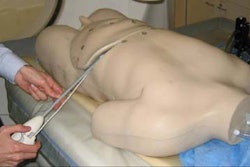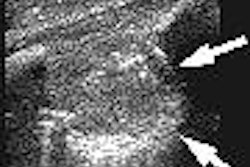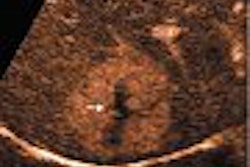Three-dimensional volume sonography is much faster and just as accurate as traditional 2D scanning for second-trimester fetal surveys, according to a presentation at the annual meeting of the American Institute of Ultrasound in Medicine (AIUM).
"The ability to obtain volumes that we can reconstruct offline is probably one of the most important advances in modern sonography," said Dr. Beryl Benacerraf of Harvard Medical School in Boston. She spoke during a categorical course at the Orlando meeting in June.
Three-dimensional imaging is certainly not new in radiology, as CT and MR have used volume imaging for decades. Now that ultrasound has gained similar capabilities, the benefits of the modality can be expanded inordinately, Benacerraf said.
"The technique of taking one 2D picture at a time while standing next to the patient and obtaining a study over 20 minutes will no longer be efficient," Benacerraf said.
Volume sonography must be viewed as a method by which all relevant anatomy is captured at once, with vastly reduced time for patients on the table, she said. Upon completion of the scan, patients can then leave the room and the entire scan is retained for a "virtual scan" to be performed offline.
To determine whether volume sonography can be a quicker and more efficient screening exam of the second-trimester fetus, Harvard researchers studied 50 consecutive 17- to 21-week fetuses who were scanned for a structural survey with a normal 2D scan.
After the standard 2D sonograph was performed by one of eight sonographers, the sonographers then obtained volume acquisitions in the regions of the head, chest, abdomen, face, and lower extremities. At least one to two weeks after the initial scans, the volumes were reviewed by three physicians on a separate workstation.
The researchers then calculated the time used to obtain the volumes, the time used to do the fetal surveys on the five volumes including biparietal diameter (BPD) and femur measurements, completeness of survey, and the time needed to complete the standard 2D study.
Three physicians then reviewed the CDs that contained the five patient volumes, with each of the physicians timing themselves in reconstructing the five volumes and performing an offline, complete structural survey. The 3D volume scans were then compared to the 2D exam to determine whether the 3D offline review was any less accurate.
The frequency of identifying anatomic landmarks on 3D was at least 94%, with the exception of fetal arms (92%). Overall, 74% of the 3D BPD measurements were within 1 mm of the 2D measurements, and 64% of 3D femur measurements were within 1 mm of the 2D measurements.
In time comparisons, it took a mean time of 1.8 minutes to obtain the volumes, with a mean time to do reconstruction ranging from 4.8 to 5.5 minutes for a total mean time for the entire volume scan ranging from 6.6 to 7.3 minutes, Benacerraf said. For 2D surveys, it took a mean time of 19.4 minutes.
As a result, the volume scans saved 12 to 13 minutes of machine/sonographer time per patient, with total room time-savings for the 50 patients of 10.3 to 10.8 hours. These findings suggest that 3D offers the opportunity to dramatically improve patient throughput, Benacerraf said.
"Ultrasound now has the capabilities similar to other cross-sectional modalities, and we need to reassess how to use our time efficiently with this new technology," she said. "Soon, the plane of acquisition is going to be irrelevant to the images produced. Volume imaging finally allows us to move ultrasound into applications and efficiency previously inaccessible to ultrasound, but previously enjoyed by CT and MR."
3D issues
Benacerraf also addressed issues relating to 3D, including patient perception and satisfaction with a much shorter exam time.
"Patients will need to be educated that what comprises the medical part of the ultrasound exam may not be the same as it used to be," she said. "No other imaging modality prolongs the exam beyond what is necessary just to please the patient."
As for concerns over incomplete exams, volumes can be checked in seconds by the sonographers or the sonologist to make sure they are adequate before the patient is let go, she said. A couple of additional images will be necessary to complete the scan, such as a picture of the placenta, cervix, and a video clip of the beating heart. This might add less than 30 seconds to the screening scan, Benacerraf said.
Adoption of 3D exams will also impact sonographers, she said. Images will not be as operator-dependent, and sonographers will spend less time scanning. That may improve the repetitive injury problems they have, Benacerraf said.
In addition, sonographers may well be called upon to reconstruct views offline from the volumes, a development that will vary their tasks and average physical time, she said.
"This would vary their job description and reduce their injuries," she said.
For physicians that scan the patient, the time for the virtual scan is probably an improvement over walking into the room, meeting the patient, and doing the scan live, Benacerraf said.
Advantages include the ability to generate missing images offline by "virtual scanning" even when the patient is gone, she said.
Displays are coming to market now that will be able to display 3D ultrasound volumes much like a CT scan, allowing users to utilize the displays much like their colleagues in CT, she said.
"We need to move ultrasound into the next arena, and we need to get out of the dark ages," she concluded. "We need to not stand next to the patient taking one picture at a time anymore, because that's not where cross-sectional imaging is at."
By Erik L. Ridley
AuntMinnie.com staff writer
July 1, 2005
Related Reading
AMA says ultrasound in-utero "portraits" are bad idea, June 22, 2005
4D ultrasound shows promise for improving fetal echocardiography, April 6, 2005
3D volume US shows promise for second-trimester fetal evaluation, March 17, 2005
3D ultrasound poised to revolutionize pelvic imaging, September 9, 2004
3D and the future of imaging, November 3, 2003
Copyright © 2005 AuntMinnie.com




















